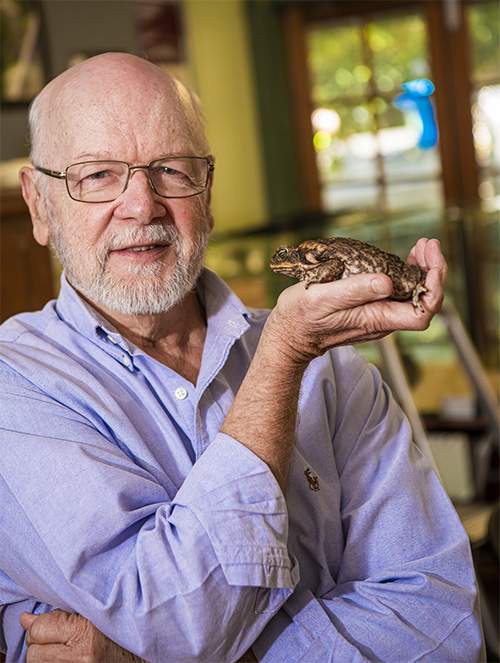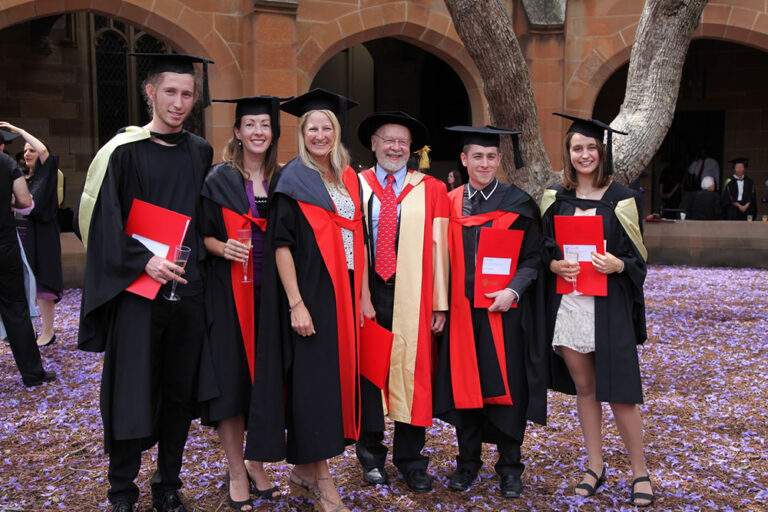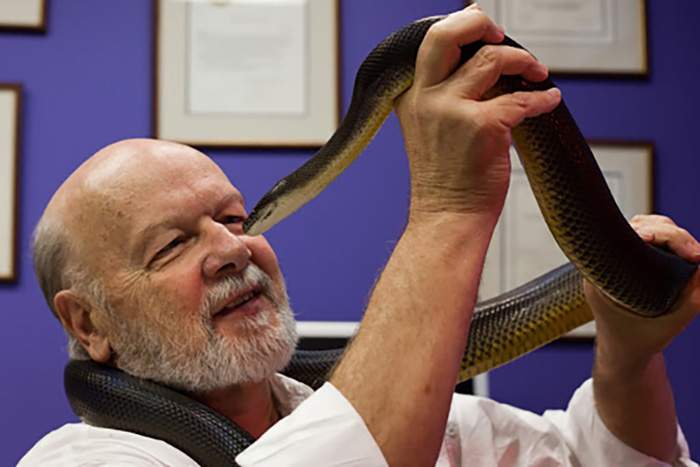- Name: Rick Shine
- Number of lab members or colleagues (excluding PI): 6
- Location: Macquarie University, Sydney
- Graduation Date: Ph.D. 1975
- H index: 122. I’ve published well over a thousand peer-reviewed papers. In 2016 I won the two biggest science prizes in Australia – New South Wales Scientist of the Year, and Prime minister’s Prize for Science.
- Grants: around $20 million or so.
- Success of your lab’s members: Many of my former students and postdocs have academic positions of their own, and several have won prestigious fellowships and awards.
I’m a research biologist, with a primary interest in ecology, evolution and conservation of reptiles and amphibians. I’ve been passionate about these animals since I was a small child, so I’ve been very fortunate to spend my career working on the animals I love and asking the questions that most interest me. I’m Australian born and bred, and have spent almost all of my career here, apart from a postdoc at the University of Utah and the inevitable overseas trips for conferences and research. I’ve conducted field studies on snakes in just about every continent.
The biggest shift in my research career came after I had already conducted a couple of decades of research on snakes in tropical Australia. A large and highly toxic species of toad from South America – the cane toad – was introduced to Australia in 1935 to control insect pests, and rapidly began spreading. In the process, millions of native wildlife were killed when they tried to eat a toad – creatures like snakes, lizards, crocodiles and carnivorous marsupials. So I put my snake research on the back burner in order to work out what the toads were doing, and how we could buffer their impact. That shift resulted in a big increase in funding (Australians hate toads, but don’t care so much about snakes) and in the size of my group. The Australian Research Council gave me generous fellowship funding, and we were able to answer most of the questions that stimulated the work.
I retired from the University of Sydney a couple of years ago, but have now taken up a part-time research position at another institution – Macquarie University. I still enjoy the research, and now I can escape most of the administrative nonsense.

As I said above, I’ve always been fascinated by reptiles and amphibians. The key to success in the cane toad project was assembling a great group, and setting out to really UNDERSTAND the invasive species, not just find new ways to kill it (which had been the focus of most other work). By getting a clear view of the toad’s biology, we soon discovered vulnerabilities that we could exploit for control. And by studying the impact of toads, we devised a simple method to render the native wildlife far less vulnerable – we simply teach them not to eat cane toads, by exposing them to small (only moderately toxic) toads just before the invasion front of large (and deadly) toads arrives at a site. We are now rolling out that program over a huge area in tropical Australia.
So I see the key as doing good basic science, and really understanding the problem before you try to solve it. Ask the organisms what’s going on, rather than reading the textbooks.

Rick and graduating students, by Malcolm Ricketts
Please describe the process of learning, iterating, and creating the project
Anyone who conducts a longterm field study needs longterm funding, and that’s a big challenge – you need to keep finding new questions to ask, because granting agencies won’t fund you if you say you just want to keep the project going (even if that is your underlying aim). So I was always on the lookout for a new angle for a grant application, and that was increasingly difficult after 20 years working at the same site in tropical Australia – even though the work had gone exceptionally well. The invasive toads were an obvious opportunity – a new study system, a biological invasion about to reach an area where we already had two decades of background information. It made for a strong application, and was funded.
The specific projects evolved based on our initial findings. I was fortunate to attract first-rate postdocs, great graduate students, and exceptional undergrads. I rented a small village next to our field site from the state government, to give us access to accommodation and lab facilities. So the logistics were in place, and that’s a key to successful field research.
Please describe the process of launching the project
With a Federation Fellowship from the Australian Research Council, I could afford to hire postdocs, students and research assistants – so the cane toad project exploded into being in 2006. I knew very little about amphibians myself – I’m a snake biologist, basically – so I immediately reached out to top experts in amphibian biology and proposed that we collaborate on sections of the work. Everybody agreed, so it was a terrific concentration of expertise applied to the problem almost from the start. Co-ordinating folks from all over the world was challenging, but we had regular workshops at the field station, and communicated in every way we could. And it was a harmonious group – my policy was always zero tolerance for bullying, harassment, fraud etc. – so we had a great time working together.
Since launch, what has worked to make your project grow?
The cane toad’s spread through Australia is an ideal model system for looking at an invasion, and at the rapid evolutionary changes spawned by an invasion. So that helped a lot – toads are easy to work on (catch, keep, breed, etc.) and are a high-profile ecological catastrophe in Australia. One of our first results was that toads have evolved longer legs in the 80+ years they have been in Australia, increasing their rate of spread enormously. We published that paper in Nature, and the idea of long-legged toads sprinting across Australia really caught people’s imagination. I think that first high-profile paper was critical in cementing our reputation.
I soon realised that we needed a “brand” and so gave my team a distinctive name (“Team Bufo”) that made it attractive to the media. And before long, we were putting a lot of effort into press releases, int obtaining striking video footage for the TV news when a story broke about our research, and so on. It was a complex political and social landscape, with some community-based groups wanting to take a more populist approach and unhappy about interference from scientists. I recently wrote a book (“Cane Toad Wars”, University of California Press 2018) to tell the story.
How is everything going nowadays, and what are your plans for the future?
Things are fine. I am still research-active but have greatly reduced the size of my group. I still work with toads, but increasingly on snakes as well.
Through your science, have you learned anything particularly helpful or advantageous?
That if you treat the people who work with you as human beings, they will strive hard and achieve great things.
We’d love to know more about you, could you please let us know what is your morning routine like?
Not long after the coffee wakes me up, I check and answer emails before heading into the office for a few hours. My policy is to answer every email immediately I open it, except for rare exceptions where I need to do something about the request first. I try to do intellectual work in the morning, while I’m fresh, and leave the dreary jobs to the afternoon. I rarely work in the evening, and weekends are family time.
And how does a typical day look for you?
Emails, then manuscript-writing and revising, plus zoom meetings with colleagues and students if appropriate (I keep meetings to a minimum. I don’t really enjoy them if there are more than 2 or 3 people involved). Because of COVID, I go home for lunch, and work from home in the afternoon.
What does your workstation look like?
Very ordinary. I use Macintosh computers, and have three desktops and a couple of laptops scattered among my office and home. I rarely print anything out – my workflow is 99% digital.
What platform/tools do you use for your professional life?
As few as possible. Microsoft Office for most things, JMP for stats.
What secondary software and apps do you use daily?
As above. I am fortunate to have a fantastic research assistant, Melanie, who has been with me fulltime (on soft money) for more than 20 years. She handles all the manuscript formatting, proof-checking etc (a big job, since I produce somewhere between 40 and 50 papers a year) and is an expert at far more programs than I am.
How do you stay up to date on News and resources?
Google Scholar is amazing. And if I get stuck, there’s always a colleague to ask via email, or a Wikipedia page to read.
What have been the most influential podcasts, or other resources?
I don’t spend much time listening to podcasts – and when I do, it’s mostly for entertainment. Most of my new ideas come from watching animals, not hearing what other people think about them. But in the pre-COVID era, my firm policy was to attend a seminar at least once or twice a week – often on topics that superficially were unrelated to my work. I found that I often got new insights from seeing how people ask questions in different branches of science.
What tools do you use in your personal life? Cook? Self Care? Hobbies?
I am an abysmal cook, and can only express my fervent gratitude to my long-suffering wife Terri, who keeps me fed and healthy. I keep fit with fieldwork, swimming, a bit of fishing and a lot of gardening. Playing soccer with grandchildren helps also!
Advice for other scientists who want to get started or are just starting out?
Follow your dream. Life isn’t a dress rehearsal. When I began my career, there was no such thing as a snake ecologist – but my work led me into that role and it’s been wonderful. You have to be somewhat strategic, and recognise your own abilities and limitations – but basically, I think there is much to be said for having a go at doing what most excites you.
Thank you very much for your time, Rick. Where can we go to learn more?
Just Google my name, or look up the following websites:

